Corymbia torreliana
Family: Myrtaceae Origin: Queensland, Australia
Cadaghi are yet another example of an endemic tree that enjoys taking over civilized life. Especially invasive, this tree has been banned from cultivation in many parts of the world including Brisbane, where we recommend removing them. Despite all of its positive characteristics that it’s developed in the wild, these same characteristics make it a very tiresome and unsuitable plant for cultivation in urban areas. And, at first glance you might not realize that this is a gum tree, as its leaves are very wide for a bloodwood.
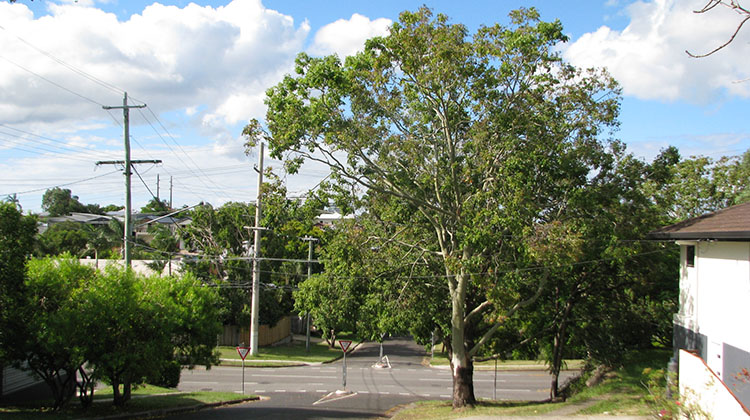 Arboriculture
Arboriculture
Growth form
The Cadaghi is considered a medium to large tree, reaching around 30 metres in height and around as wide. It’s usually large and open form is imposing yet unique. It usually holds its branches in every direction, and in cultivation heavily benefits from careful pruning to train it into a suitable and attractive form for the landscape. Left on its own, it grows large and full and in every direction at once.
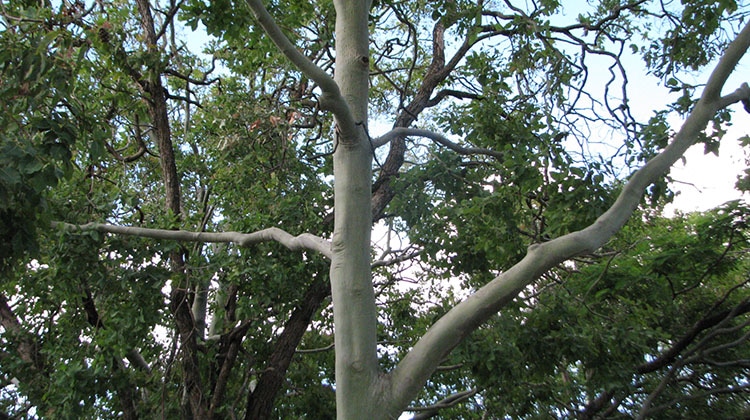 Trunk
Trunk
The trunk contains some amount of chlorophyll that helps it photosynthesize and create food. Its color is a light greyish green and usually smooth. This tree is usually found with a single short trunk where it begins to immediately branch out with main stems above the single trunk.
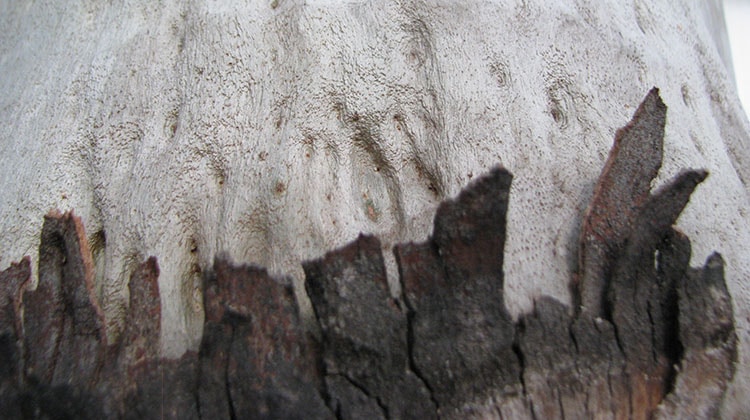 Flowering
Flowering
The flowers are very fragrant and white, and are highly attractive to pollinators. This tree blooms throughout the warm season.
Foliage
Don’t necessarily expect a eucalyptus-like leaf from this tree. The leaves are broad, fuzzy, soft, and young growth leaves are reddish bronze.
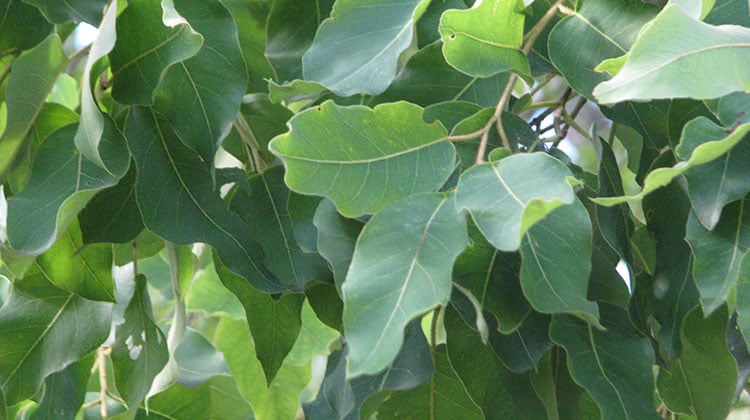 Fruits
Fruits
The nuts of this tree are used by many, and in its native range, the attractiveness of this tree’s nuts are part of the reason why it is easily controlled from growing out of control. Bees use a resin found in these nuts to make their nests. You can find these nuts available online as some enjoy using these, and they are also enjoyed by wildlife as a food source. The nuts are urn shaped and green.
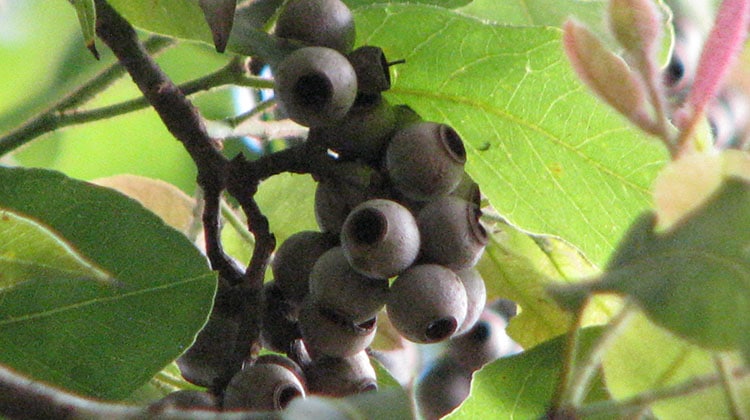 Management
Management
Propagation
The Cadaghi is easily started from seed. So easily in fact, that it’s very invasive! You can sow seeds into pots, or plant them right away before the first frost in the ground. Germination is fast, or can take a few weeks.
Cultivation
Trillianas require little care once established. They enjoy lots of sun and even some shade when young, and are grown in all sorts of soils as long as they’re well-draining. This tree doesn’t require a lot of feeding or special watering.
You can help avoid spreading this tree by collecting the nuts, or bagging the flowers when they appear to stop them from pollinating and creating nuts in the future on smaller trees. Remove seedlings as you find them too. Take special care to avoid planting this tree near buildings, as it’s known to create a sap that is loved by a black and unsightly mould. When the sap is moved with high winds, the mould finds it where it lands- on houses and buildings, on cars, on anything. It’s very hard to remove and clean.

I have a very large cadaghi tree on my property. Looks handsome, BUT plants under the tree struggle, due to black sooty stuff covering them. I have decided to remove this tree. Am I doing the right thing?
How do I remove cadaghi sap from my car windscreen ?
Is it normal for the cadaghi gum tree to lose its rough bark down the bottom when shedding
Should I be removing the new gadaghi trees as they sprout in paddocks
Hello, we have a cadaghi in our yard. It provides welcome shade and the birds (noisy miners) love it. Only one problem MOULD! it’s on everything, including our roof. Is there any way we can control this without having the tree removed? I’d be sorry to see it go but what can we do?
Please also becareful with these trees as the root system is invasive if they bust through underground water pipes they can drink upto 400 litres per day.
Hi David,
I am hoping you can help with the best option to have a dangerous Cadaghi removed from my neighbours property. It is ~ 30 m tall, with at least half of the branches hanging over our property and the house. It is only 1m from the fence line. It has started dropping large branches which would kill someone if they were under it or write off a car. The branches are so large, iI cannot even lift them. It is not safe to leave a car in the driveway. We live in fear during a storm. I have contacted Logan City Council, who advised they do not look after trees, and referred me to QCAT. After speaking to them, I have found it will be a drawn out process, which can take up to 6 months, and could cost over $1000 to take to court with no guarantee of the tree being removed. The property is rented, and the owner performs no maintenance on the property , so there is no willing buy in from them to remove the tree, or even the branches. In fact there, are now more of trees trees popping up on their land. . Hoping you can provide me with some options apart from QCAT or mediation. I cannot believe there is not another option to remove a dangerous tree , especially when it is classified as a weed.
G’day David
We have a huge Cadaghi out front – on council property. We’ve been requesting Council to remove it from our “suburbia”for years – all the usual issues as mentioned by other people -, but Council says “it’s a lovely tree and yes, it shouldn’t have been planted here etc, but it’s so healthy”
We’ve just had a “forensic engineer” do a report on our house, because of some movement issues. He suggests in his report that the tree (he didn’t know the species) is one of the issues – taking moisture from the ground, causing the soil to settle, and hence “pulling” our front patio away from the house.
My question,and I can’t seem to find anything on the “net” yet, is -how far does the Cadaghi gum root system travel to get moisture?
The tree is about 9me from our house – it is at least 15me high.
We live on the Sunshine Coast.
Look forward to your reply
Bill
I have 6 of them and they are getting very dangerous as there limbs are breaking off , they are next doors trees and they hang over my house I,m waiting for the day a limb comes through my roof or hits one of my Grandkids what should I do
Laurie
Hi David,
We live in a life style resort, and have a large cadaghi tree within 20 metres of 3 villas. The tree is causing us concern. It has shed branches and copious amounts of bark ,last summer. Tweed Council has said it could be removed,.An arborist inspected the tree and stated the tree “has excellent vitality”. therefore no action was taken. The tree is now flowering, attracting bats and creating significant mess each morning. Your comment regarding the sap which in turn attracts mould is of particular concern given our closeness to the tree. How best to remove the sap/mould if it appears? Also is there any information on health issues with the small fibres from the flowers which covers our homes, as I am asthmatic.
Buy a unit in the city
They need to be removed my husband worked in a retirement village as grounds maintenance and had them removed because their root kept breaking pipes and were drinking upto 400litres a day.
David can you tell me if it would be possible that the vegie garden under the drip line of the Cadagi tree could become toxic (so to speak) We have replaced the soil in all our vegie gardens and the others are doing great except this one. I realise it could be the roots sapping the moisture??? but when the flowers are out the garden becomes covered in total with the yellow of the flowers and then we get the bulbs of course and trees have been known to come up by the dozens in this garden?? Thanks any advice would be helpful. Unfortunately the tree is not in our yard.
Hi David we have a problem with a big cadaghi Corymbia torreliana that is just outside our gate on council land. We are living in the Northern Rivers. We have numerous times asked council to get rid of it, but they wont hear us. It is a very big tree that leaves a huge mess (full green bin every week including that of our neighbours) It attracts bats , very noisy throughout the night. Underneath or in front of the tree, on our land is a Pontiana well maybe was because it looks like it is struggling , including other bushes , grass and natives since the sap is leaking out of the tree. Also the branches have to be cut down all the time as they reach the powerlines. The tree is approx 7 meters from the house. I do have photo’s if you would like to have a look at it and give me your thoughts.. At the moment we are dealing with a burst waterpipe just a meter from the tree, council is sending someone over to have a look….regards Lisette
Lisette,
I feel your pain. Councils can be very frustrating to deal with. I’d be phoning back the tree department of your council with the new problem about the water pipe, to start.
You are quite right about a large tree making it difficult for neighbouring trees to be able to compete for resources. Unfortunately that’s not something your council is going to care about, though. I’d suggest pointing out the dangers. Liability is something councils do care about. Of course it’s much better if that is coming from a third party, so you’ll have to weigh up if you are prepared to pay for a visit from a local arborist who can check the tree for faults.
I’d suggest a phone call or two to see if you can find a sympathetic ear. You might find an arborist who will drop by to have a look without charge, though if it gets to the point of a written report you’ll have to pay a fee. Most arborists are going to be on your side, considering the invasive status of Corymbia torrelianas.
Hi David thank you for your reply,
unfortunately things have gone ugly;
after council fixed the pipe, the council’s tree hugger, a truly nice man came to have a look. To my horror he showed me big holes that have been drilled in the tree and we suspect poisoning.. (hence the enormous loss of leaves and sapping?) Mr tree hugger said that the tree has been put on the list for removal with other trees around the area a while ago , as previously there was no budget to remove. I am really upset as I very much suspect one of our neighbours to have committed this crime. ( it is!!) We are moving to another place but on a very sour note now as this should not have happened to this tree. I have no idea what impact this will have on the tree and the environment, but this is an ugly way to go! Very disappointing.and unexpected outcome…to be continued…